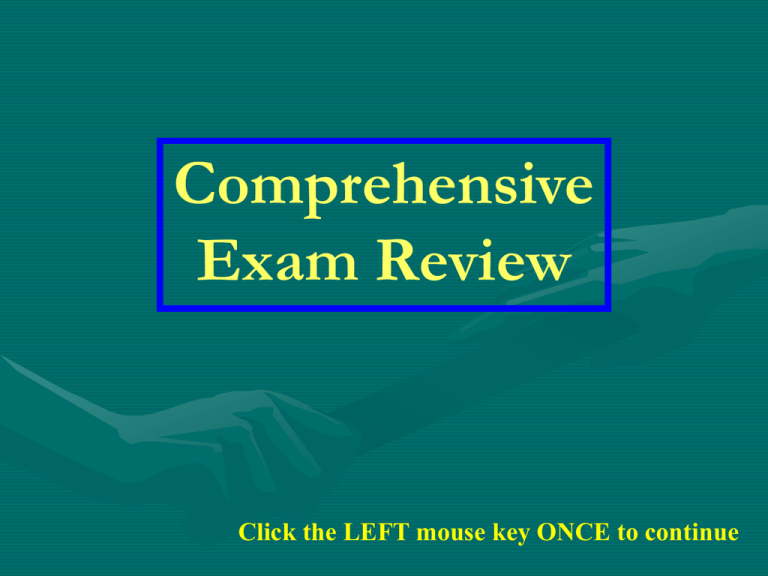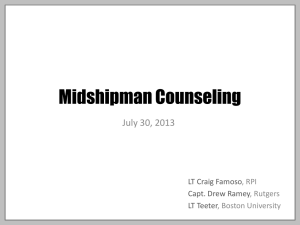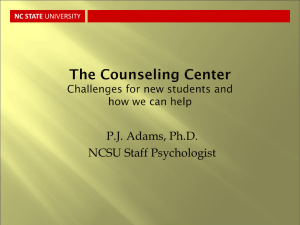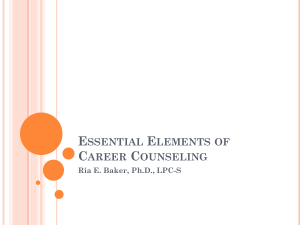
Comprehensive
Exam Review
Click the LEFT mouse key ONCE to continue
Helping
Relationships
Part 4
Click the LEFT mouse key ONCE to continue
Models of Helping
Egan proposed three basic communication
skills for the helping process.
1. Attending, which follows the acronym
SOLER:
face the client Squarely.
adopt an Open posture.
Lean toward each other.
maintain Eye contact.
appear Relaxed.
2. Active Listening, which includes nonverbal
behavior as communication and punctuation,
and Verbal Behavior as indication of
productive understanding and communication of what the client is saying.
3. Empathy, which is the counselor’s
ability to draw from personal experiences,
emotions, and behaviors and to make
responses indicating a shared understanding of the client's experiences,
emotions, and behaviors.
Egan proposed a three stage model of
counseling:
In Stage 1, Reviewing the Problem, the goal is
to help the client identify, explore, and clarify
problem issues and unused opportunities.
In Stage 2, Developing the Preferred Scenario,
the goal is to help the client identify what is
wanted as outcomes based on the problem
situation and opportunities.
In Stage 3, Determining How to Get There,
the goal is help the client take action based
on what they have learned in counseling
and to translate that learning into
strategies for accomplishing counseling
goals.
Egan proposed that the basic helping
process values include
Pragmatism
Competence
Respect
Genuineness
Client Self-Responsibility
Reconciliation of Self-Responsibility
and Social Influence
Ivey’s Microskills model includes
1. Attending Behavior, which means that
the counselor uses culturally and
individually appropriate behaviors.
2. Open and Closed Questioning, which
elicits the specifics of the client's world.
3. Client Observation, which means
attending to the client’s verbal and
nonverbal behaviors and discrepancies
skills.
4. Encouraging, Paraphrasing and Summarizing,
which are used to help the client organize
thinking and communicate clearly.
5. Reflection of Feelings, which lets the client
know that feelings and emotions have been
understood.
6. Five-Stage Interviewing, which includes (a)
rapport building/structuring, (b) defining the
problem, (c) defining a goal, (d) exploration of
alternatives and confronting incongruity, and (e)
generalization to daily life.
7. Confrontation, which is the identification
of the client’s incongruities and mixed
messages.
8. Focusing, which means attending
substantively to all pertinent facets of the
client’s situation.
9. Reflection of Meaning, which lets the
client know that communications have been
understood.
10. Influencing Skills, which include (a)
developmental questioning, (b) directives, (c)
logical consequences, (d) interpreting/reframing,
(e) self-disclosure, (f) advice/information /
explanation/instruction, and (g) feedback.
Wittmer and Myrick’s Facilitative Model
includes six counselor responses, ranked from
the least to the most effective:
1. Advising or Evaluating, which tell a person
what they should do in the way of feeling or
behaving or convey the correctness of a
behavior or feeling.
2. Analyzing and Interpreting, which have the
intention of explaining behaviors or feelings
but imply what the client should think or do.
3. Reassuring and Supporting, which is the
intention to indicate belief in the client’s
ability to solve the problem, but often imply
that the client should not feel as he/she does
feel.
4. Questioning, which seeks more
information, provokes further discussion, or
queries an individual about a specific matter.
5. Clarifying and Summarizing, which
indicate desire to be accurate in the
communication and to indicate that the
counselor is accurately hearing what the
client has said.
6. Reflecting and Understanding of Feeling,
which convey the counselor’s accurate
perception of the client's emotional experience.
Myrick proposed an eight stage model of
counseling:
Stage 1, Beginning and Orientation, which is
characterized by getting acquainted, collecting
background data, establishing rapport, defining
roles and expectations, making initial
assessments, and setting counseling goals.
Stage 2, Building the Relationship and
Assessment, which includes formal and informal
assessment (the latter of which are the counselor's
observations and impressions of the client).
Stage 3, Exploring and Discovery, which is the
working stage.
Stage 4, Centering and Setting Goals, which is
the time to determine and establish a clear
picture of what the client wishes.
Stage 5, Planning and Taking Action, which is
defining the steps and skills needed to
accomplish the client’s desired goal.
Stage 6, Collecting Data and Action, in which
an action plan is implemented and progress is
monitored, with adjustments as needed.
Stage 7, Follow-up and Evaluation, which is
a review of accomplishments and assessment of progress.
Stage 8, Closing and Separation, which is the
time to review what has been learned and to
terminate.
Carkhuff advocated:
Listening, including knowing the reason for
listening, suspending personal judgment,
focusing on the client, practicing being silent,
repeating verbatim what the client said,
looking for commonality in client's responses,
and reflecting on the content of what the client
has said.
Responding to Feelings, especially restating
client verbalizations.
Responding to Behavior, including
responding to the client’s physical energy and
activity, individuality, stereotyped behavior,
and incongruent behavior.
Initiating Confrontations, especially identifying discrepancies between verbalizations and
behaviors.
Productive Program Development, including
preparing for action, clarifying problems,
setting goals, defining objectives, developing
tasks, developing action steps, employing
check steps, attaching criteria, designating
milestones, attaching timelines, and
implementing program.
Basic Concepts in Counseling
Special Populations
Substance Abuse Counseling
Substance abusers are persons who use a
substance to the extent that it causes damage
to them or society or both.
Substance abuse counselors have specialized
training in pharmacological, physiological,
psychological, and sociocultural aspects of
addiction.
The substance abuse counselor's role
includes prevention, intervention and crisis
treatment, both group and individual
counseling, and working with both formal
and informal treatment teams.
Counseling Women
Counseling women, sometimes referred to
as gender-fair counseling, includes
attention to INAPPROPRIATE sex-role
stereotypes such as that women:
have lower self-esteem.
are better at rote learning and repetitive
tasks, while men are better at
higher learning cognitive
processing and the inhibition of
previously learned responses.
Inappropriate sex-role stereotypes continued
are less analytic.
are affected primarily by heredity, while
men are affected by environment.
lack achievement motivation.
are more fearful, timid, and anxious.
are passive and men are active.
have total legal equality with men.
are more easily duped than men.
Inappropriate sex-role stereotypes continued
are less competitive.
are more compliant.
are more nurturing.
are more emotional.
are less aggressive than men.
are better at verbal ability while men are
better at mathematical ability.
Gender-Fair Counseling includes:
heightened awareness of personal,
particularly sex-role, values.
Gender-Fair Counseling continued
realization that there are no prescribed
sex-role behaviors.
understanding that reversals of traditional
sex-roles are not pathological.
realization that marriage is not a better
outcome of therapy for a female
than for a male.
women can be as autonomous and
assertive as men and men can be as
expressive and tender as women.
Gender-Fair Counseling continued
awareness that anatomical differences
are not a basis for theories of
behavior.
understanding that failure to achieve
culturally prescribed sex-role
behaviors is not a basis for
diagnosis.
use of assessment instruments that are
sexually biased should be avoided.
Multicultural Counseling
Many culturally different populations do
not wish to be acculturated due to fear of
loss of their cultural identity.
Nondirective counseling techniques are
often inconsistent with the expectations and
values of some minority groups.
Suggested reasons for ineffectiveness of
counseling with minority group members
include that:
many assessment instruments are culturally
biased and many diagnosticians are
not from a minority group; therefore,
many minority clients are
(mis)diagnosed as having more severe
mental illnesses.
Reasons for ineffectiveness continued
minority group member attitudes about
sources of mental illness are sometimes markedly different from those
of majority populations.
minority populations tend to use mental
health services only in extreme
circumstances, which greatly skew
statistics about persons using mental
health services.
Reasons for ineffectiveness continued
differences have been noted between black
and white clients, with the black
clients receiving more punitive therapies,
such as stronger medications, restraints,
or seclusion.
there are few counselors with whom
minority clients feel comfortable and
share cultural identity.
Reasons for ineffectiveness continued
minority clients often are misperceived
because of cultural differences in
nonverbal communication.
minority clients tend to drop out of treatment
earlier, for unknown reasons,
generating speculation that they may
be either less motivated or not perceive
services as helpful.
Reasons for ineffectiveness continued
some minority clients view counseling as a
controlling force to direct them away
from their normal cultural behavior.
Recommended counselor skills for effective
multicultural counseling include:
ability to recognize direct and indirect
communication styles.
sensitivity to nonverbal cues.
Effective multicultural skills continued
demonstrated interest in the culture.
awareness of cultural and linguistic
differences.
sensitivity to cultural myths and
stereotypes.
concern for the welfare of persons from
another culture.
Effective multicultural skills continued
ability to articulate elements of his or her
own culture.
appreciation of the importance of
multicultural teaching.
awareness of the relationships between
cultural groups.
accurate criteria for objectively judging
"goodness" and "badness" in the
other culture.
Characteristics of effective multicultural
counselors include that they:
understand their own values and
assumptions of human behavior and
recognize that those held by others
may differ.
realize that "no theory of counseling is
politically or morally neutral."
understand that external sociopolitical forces
may have influenced and shaped
culturally different groups.
Effective counselor characteristics continued
are able to share the worldview of their
clients rather than being culturally
encapsulated.
are truly eclectic in their counseling and
use various counseling skills due to their
appropriateness to the experiences and
lifestyles of the culturally different.
Counseling Older Persons
The primary goal in counseling older
persons is to help them find meaning and
appropriate roles and behaviors in life.
There are more older females than males,
but counselors should be aware of the
unique needs specific to each gender.
Of special interests are services for older
persons living alone that provide opportunities to meet others and for companionship.
Although the physical needs of older persons
are often recognized, their social, emotional,
and psychological needs have received
relatively little attention.
Each community has an older person
population, and older persons tend to group
geographically, which suggests that
community services be located in areas of
concentration.
Most older persons have fixed incomes,
which implies that older adults will need
more public than private-fee services.
Existing counseling services in employment
service and vocational rehabilitation should
be expanded to include services for older
persons.
Although most older persons are able to
travel to receive services, counseling-related
services provision should include consideration of transportation, home delivery,
homebound, and human or mechanical aid
needs.
Changing demographics of the population of
the United States suggest that the need for
counseling for older persons will continue to
increase, and increase dramatically.
Counselors need to be social activists against
“ageism” that prevents older persons from
receiving adequate mental health care.
Possible developmental points of crisis for
older persons include retirement, loss of
spouse, physical and mental decline, financial
security decline, and decline in mobility.
Counseling in Business and Industry
Counseling in business and industry often
takes place within the context of an
Employee Assistance Program (EAP).
EAPs are sometimes provided “in house” by
the company, but more typically are
contracted services to a mental health agency.
EAPs typically have a heavy emphasis on
addictions counseling, but also provide a wide
variety of counseling services to employees.
Typical components and characteristics of an
EAP include:
crisis and early intervention.
a self, peer, or supervisor referral system.
services that are confidential.
support from management, leadership
and/or unions.
informed consent for all participants.
EAP components and characteristics
continued
payment by insurance contract.
provision of services without influence
of work performance evaluation.
staffing by trained helping professionals.
follow-up and program evaluation.
Counseling Persons with HIV/AIDS
Persons with HIV/AIDS typically experience
emotional difficulties, including isolation and
alienation, a drop in self-esteem, and denial
as a coping strategy.
Counseling services to persons with
HIV/AIDS include assessment of risk;
education about disease, risk behaviors, and
safe sex; and teaching new behaviors.
Counseling goals for working with persons
with HIV/AIDS include:
helping the individual to reconcile the
diagnosis and its meaning.
encouraging improvement in quality of life.
encouraging clients to take more control of
their lives and their illness.
providing emotional and practical support
as needed by the client.
Counseling Abuse Victims
Spousal abuse has been associated with
poverty, substance abuse, and career
disappointments, but occurs across all social
strata and environments.
The most frequently used spouse intervention are crisis hotlines and shelters.
However, many do not employ trained
helping professionals.
Sexual abuse data indicate that:
8% to 38 % of women and 5% to 9 % of
men in the U.S. have been sexually
victimized.
sexual abuse is an international concern,
although exact data are unavailable.
male perpetrators are most common, with
95% of female and 80% of male abuse
victims reporting having been abused
by males.
the most common age for sexual abuse is
8 to 12 years of age.
Sexual abuse data continued
stepfathers are more likely to be the sexual
abuser of daughters than are
biological fathers, although other
family members may be offenders.
women are more likely to be victimized by
persons within the family.
men are more likely to be abused by persons
outside the family.
The emotional effects of child sexual abuse
may result in “loss of childhood,” guilt, low
self-esteem, fear, confusion, depression,
anger, low trust level, helplessness, and
altered attitudes toward sexuality.
Counselors who work with abuse victims
should have special skills in individual,
group, crisis, short-term, and family
therapy, and thorough knowledge of how to
work with the guilt, stigma, fear, and post
traumatic stress syndrome.
Counseling Gays and Lesbians
Because of the controversial and contradictory information that exists in the
research and professional literature,
recommended guidelines for counseling this
special population remain confusing.
Major concerns faced by gay and lesbian
clients, while not unique to them, include
social prejudice, family conflicts, ridicule and
rejection from peers, and health concerns,
especially HIV/AIDS.
Recommended counseling strategies for gay
and lesbian clients include:
Cognitive approaches to overcome negative
thinking and self-talk.
Gestalt techniques to facilitate expression of
ambivalence and confusion.
Feminist approaches to help clarify roles and
increase feelings of empowerment.
Bibliotherapy to help define a healthy lifestyle
and provide role models.
Recommended counseling strategies
continued
Family/systems therapy to work on
relationship issues.
Group therapy to help with alienation issues.
Cross-cultural approaches to assist with
complex cultural diversity issues.
This concludes Part 4 of the
presentation on
Helping Relationships









